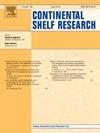Macrofauna community structure and population dynamics in the Flemish bank region: Assessing long-term change in the Anthropocene
IF 2.2
3区 地球科学
Q2 OCEANOGRAPHY
引用次数: 0
Abstract
Benthic communities in continental shelf seas are influenced by human activities, yet assessing long-term change remains impeded by the scarcity of baseline data predating the proliferation of human activities. In this study, we considered the oldest macrofauna data from Van Veen samples collected in autumn 1970–1971 in a shallow soft-sediment seabed south of the Nieuwpoort Bank in the Belgian Part of the North Sea (BPNS). Both archived data in notebooks and hitherto unprocessed samples were considered. The community structure and biodiversity of these samples were compared with samples from autumn 2016. Furthermore, we compared (bi)monthly dynamics of indicator taxa for muddy sands (Abra spp.) and fine-medium sands (Nephtys spp.) present in the area with a time series collected in 2002–2003. Our findings reveal that both habitat types became richer in macrofauna species number and diversity. The invasive species that colonized the area between sampling periods explained <1 % of observed community structure changes. Overall, most taxa had higher population densities in 2016 compared to 1970–1971. Population densities varied seasonally, peaking in August 2016, and with less distinct recruitment dynamics in 1970–1971, confirming lower overall population densities in that period, especially for Abra. We discuss these results in relation to datasets discrepancies, climate variability, and sediment fining, acknowledging limitations in sampling design and processing methods. Nevertheless, this data rescue exercise proved valuable for understanding marine ecosystem changes, highlighting the potential of ‘old’ archived data and samples from the early Anthropocene.
佛兰德河岸地区大型动物群落结构和种群动态:评估人类世的长期变化
大陆架海域的底栖生物群落受到人类活动的影响,但由于缺乏人类活动扩散之前的基线数据,评估长期变化仍然受到阻碍。在这项研究中,我们考虑了1970-1971年秋季在北海比利时部分(BPNS)新港岸以南的浅层软沉积海底收集的Van Veen样本中最古老的大型动物数据。笔记本中存档的数据和迄今未处理的样本都被考虑在内。将这些样本的群落结构和生物多样性与2016年秋季的样本进行比较。此外,我们还比较了该地区泥质砂(Abra spp.)和细砂(Nephtys spp.)的指示分类群的月动态与2002-2003年的时间序列。结果表明,两种生境类型的大型动物种类数量和多样性都有所增加。在两个采样周期之间,在该地区定居的入侵物种解释了1%的观察到的群落结构变化。总体而言,与1970-1971年相比,2016年大多数分类群的种群密度更高。人口密度随季节变化,在2016年8月达到峰值,1970-1971年的招聘动态不太明显,证实了该时期的总体人口密度较低,特别是对Abra而言。我们将讨论这些结果与数据集差异、气候变率和沉积物细化的关系,并承认采样设计和处理方法的局限性。然而,事实证明,这项数据救援工作对于了解海洋生态系统的变化是有价值的,它突出了早期人类世的“旧”存档数据和样本的潜力。
本文章由计算机程序翻译,如有差异,请以英文原文为准。
求助全文
约1分钟内获得全文
求助全文
来源期刊

Continental Shelf Research
地学-海洋学
CiteScore
4.30
自引率
4.30%
发文量
136
审稿时长
6.1 months
期刊介绍:
Continental Shelf Research publishes articles dealing with the biological, chemical, geological and physical oceanography of the shallow marine environment, from coastal and estuarine waters out to the shelf break. The continental shelf is a critical environment within the land-ocean continuum, and many processes, functions and problems in the continental shelf are driven by terrestrial inputs transported through the rivers and estuaries to the coastal and continental shelf areas. Manuscripts that deal with these topics must make a clear link to the continental shelf. Examples of research areas include:
Physical sedimentology and geomorphology
Geochemistry of the coastal ocean (inorganic and organic)
Marine environment and anthropogenic effects
Interaction of physical dynamics with natural and manmade shoreline features
Benthic, phytoplankton and zooplankton ecology
Coastal water and sediment quality, and ecosystem health
Benthic-pelagic coupling (physical and biogeochemical)
Interactions between physical dynamics (waves, currents, mixing, etc.) and biogeochemical cycles
Estuarine, coastal and shelf sea modelling and process studies.
 求助内容:
求助内容: 应助结果提醒方式:
应助结果提醒方式:


